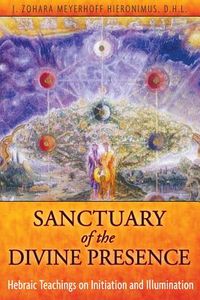
Sanctuary Of The Divine Presence: Hebraic Teachings On Initiation & Illumination
Many synagogues and churches, including the First and Second Temples of the Hebrews, follow an archetypal design first used in the Ohel Moed, or Tent of Meeting, and its sacred Tabernacle, which housed the Ark of the Covenant and the Ten Commandments. Drawing from a wealth of sources including the Hebrew Bible, the oral Mishnaic tradition of Judaism and 16th-century Judaic texts, Zohara Hieronimus explains how, like the Ohel Moed, we are designed to receive and reflect the divine qualities of the Creator. Exploring the kabbalistic initiatory teachings within the Chassidic tradition of Judaism and the lives and writings of the Hebrew prophets, she reveals how our physical and spiritual worlds are not separate but interdependent, one affecting the other, often in unexpected and sometimes miraculous ways. Examining the ten-part system of Kabbalah's Tree of Life as reflected in the holy design of the Hebrews' first Sanctuary, Hieronimus shows how the Tree of Life's ten sefirot correspond to the Torah's prophetic Ten Songs of Creation; to alchemical ritual practices of fire, water, air and earth; and to specific parts of the body, emotions and aspects of the soul. Starting from Malchut (Kingdom) at the bottom of the Tree of Life and ascending to Keter (Crown) at the top, the author discusses related biblical and scholarly texts and traditional Hebrew practices and teachings that can lead to spiritual enlightenment, illumination and peace, allowing each of us to become a sanctuary for God's presence through self-refinement, ritual devotion and prayer, as practised since biblical times. · Reveals practices for self mastery and revelation based on the holy design of the first Hebrew sanctuary, the lives of the Hebrew prophets and the tree of Life · Shows how the tree of Life's ten sefirot correspond to the torah's prophetic ten Songs of Creation; to alchemical ritual practices of fire, water, air and earth; and to specific parts of the body, emotions and aspects of the soul
Utgiven: 2012
ISBN: 9781594773754
Förlag: Inner Traditions
Format: Häftad
Språk: Engelska
Sidor: 512 st
Many synagogues and churches, including the First and Second Temples of the Hebrews, follow an archetypal design first used in the Ohel Moed, or Tent of Meeting, and its sacred Tabernacle, which housed the Ark of the Covenant and the Ten Commandments. Drawing from a wealth of sources including the Hebrew Bible, the oral Mishnaic tradition of Judaism and 16th-century Judaic texts, Zohara Hieronimus explains how, like the Ohel Moed, we are designed to receive and reflect the divine qualities of the Creator. Exploring the kabbalistic initiatory teachings within the Chassidic tradition of Judaism and the lives and writings of the Hebrew prophets, she reveals how our physical and spiritual worlds are not separate but interdependent, one affecting the other, often in unexpected and sometimes miraculous ways. Examining the ten-part system of Kabbalah's Tree of Life as reflected in the holy design of the Hebrews' first Sanctuary, Hieronimus shows how the Tree of Life's ten sefirot correspond to the Torah's prophetic Ten Songs of Creation; to alchemical ritual practices of fire, water, air and earth; and to specific parts of the body, emotions and aspects of the soul. Starting from Malchut (Kingdom) at the bottom of the Tree of Life and ascending to Keter (Crown) at the top, the author discusses related biblical and scholarly texts and traditional Hebrew practices and teachings that can lead to spiritual enlightenment, illumination and peace, allowing each of us to become a sanctuary for God's presence through self-refinement, ritual devotion and prayer, as practised since biblical times. · Reveals practices for self mastery and revelation based on the holy design of the first Hebrew sanctuary, the lives of the Hebrew prophets and the tree of Life · Shows how the tree of Life's ten sefirot correspond to the torah's prophetic ten Songs of Creation; to alchemical ritual practices of fire, water, air and earth; and to specific parts of the body, emotions and aspects of the soul
Begagnad bok (0 st)
Varje vecka tillkommer tusentals nya säljare. Bevaka boken så får du meddelande när den finns tillgänglig igen.



